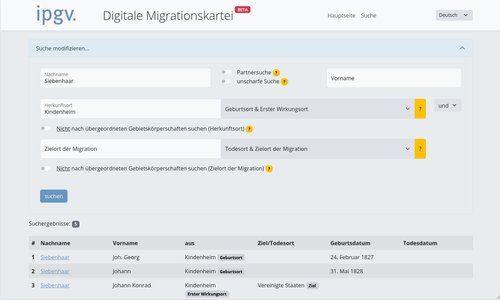Digital Migration Database

What is the Digital Migration Database?
Among the treasures of the IPGV is the extensive Migration Database with about 300,000 records, which covers more than one million migration movements from the 16th century onwards. Early on, the need was recognized to transfer this information from analog index cards to a digital format. However, presenting the digital representation of migration movements on an easily usable research platform proved extremely challenging due to the complexity of the underlying data. We are pleased to now grant you access to the beta version of our Digital Migration Database through migration.pfalzgeschichte.de.
go to the Digital Migration Database
Why "Beta Version"?
The Digital Migration Database is currently still in active development. This means that the entire platform will continue to evolve and expand in the future. As a result, some features may change over time or new ones may be added. Conversely, this implies that the current platform does not yet have all the functionalities we have planned for researching the Digital Migration Database. However, the development process may also come with minor errors, which we try to minimize through internal testing platforms.
What does the Beta Version of the Digital Migration Database include?
You can research the entire digitized collection of the migration database. Further details can be found in the information box on the homepage of the Digital Migration Database. Currently, you can search by names and/or by places of origin or destination. An explanation of the various search options is available in the corresponding information box on the search page. All functions and options are also explained on the spot with examples.
What is planned for the future?
On the content side, the remaining index cards are constantly being entered to make them accessible for research. On the technical level, the search functionality, as well as the presentation of search results up to the detailed view of individual personal information, will be expanded and adjusted. In the future, the Digital Migration Database is intended to be searchable based on additional criteria, such as professions. The sorting of search results should be customizable according to specific criteria. Location information will be linked with geodata to visualize migration movements on maps. Additionally, further options for the visual representation of search results and migration movements will be introduced. By standardizing personal and migration data through the Common Authority File (GND) of the German National Library, we aim to enable clear assignment of information and further interconnection of our datasets.
Consent and Commitment Declaration
To access the IPGV collection, especially the genealogical inventory ("QAF"), a consent and commitment declaration must be signed to protect personal information, as legally protected under § 3 (2) and § 3 (3) of the State Archives Law of Rhineland-Palatinate. The commitment declaration will be provided to you for signature during your visit to the IPGV.
What other research opportunities are available?
Since the institute fire in 2019, it is no longer possible to conduct research in the original collections of the migration database. The Quellensammlung zur Auswanderungs-Forschung (QAF) can be viewed at the institute by appointment and arrangement. Please contact: migration@institut.bv-pfalz.de for further information. Please note the explanation of the special commitment declaration in the box.
Technical Information
The technical platform of the Digital Migration Database was developed from 2021 onwards by Dr. Maximilian Lässig at the IPGV to adequately represent and make searchable the complexity of the stored information. As a considerable amount of digitized material was already available from previous digitization attempts (approximately half of the original migration database), this information had to be automatically analyzed, transformed, and transferred to the new system. The entry of the remaining database takes place on the newly created platform. Since the data from the old digitization process was not standardized, entered into the system without standardization, and could not always be fully recognized during its automatic transformation, some associations, such as places to their superordinate territorial entities, may be missing. In addition to entering the remaining database information, we are also working to standardize the information from the old digitization process and adapt it to our system accordingly. We appreciate your understanding for any inconsistencies that may arise.
Contact
For general or content-related inquiries, please contact migration@institut.bv-pfalz.de. For technical questions, please contact Dr. Maximilian Lässig. If you'd like to research on-site, please schedule an appointment (see above).
Please note that we do not conduct individual research and do not provide individual technical support. If you encounter technical issues, please perform a detailed troubleshooting on your end first. Refer to the explanations on the specific pages, please.
Project Team
- Angelika Hertzler (content processing)
- Dr. Maximilian Lässig (technical conception and implementation)
- Barbara Schuttpelz, M.A. (content conception)